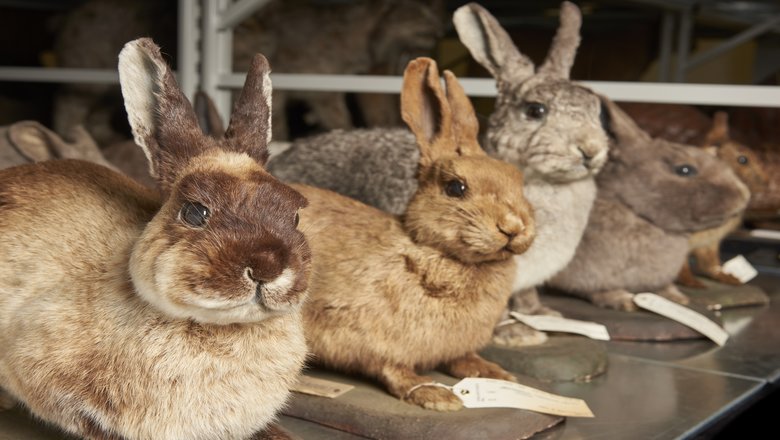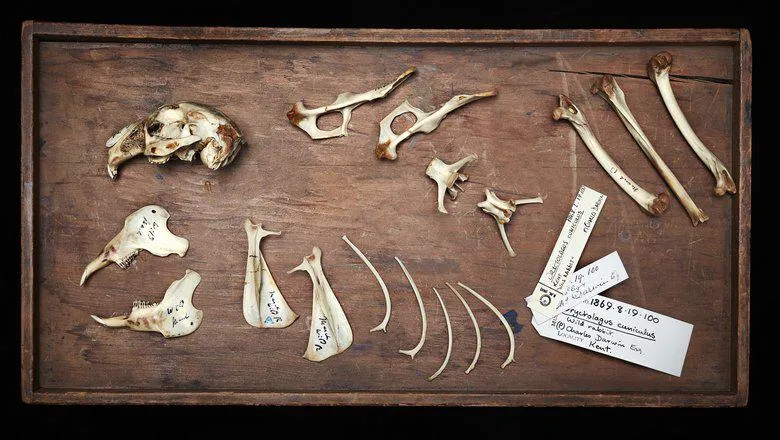14 February 2019
Darwin's rabbit helps to explain the fightback against myxomatosis through natural selection
Nearly seventy years after myxomatosis decimated the rabbit populations of Australia, Britain and France, a new study reveals how the species has evolved genetic resistance to the disease through natural selection.

Picture credits: Trustees of the Natural History Museum
An unprecedented study of rabbit DNA spanning 150 years and thousands of miles has revealed the genetic basis for the animal’s fightback against the deadly myxoma virus. Using the latest technology, an international team including Kings, the University of Cambridge and CIBIO Institute in Porto, extracted DNA from nearly 200 rabbits dating from 1865–2013, including one owned by Charles Darwin. The scientists then sequenced nearly 20,000 genes to pinpoint mutations that have emerged since the myxomatosis pandemics of the 1950s.
The study, published today in the journal Science, establishes that modern rabbits in Australia, the UK and France have acquired resistance to myxomatosis through the same genetic changes. The scientists also discovered that this resistance relies on the cumulative impact of multiple mutations of different genes.
Australia unleashed myxomatosis on an out-of-control rabbit population in 1950. The European rabbit is thought to have been introduced to the country by Thomas Austin, an English settler, in the 1850s. Within a century, they numbered hundreds of millions. The species wreaked havoc on Australia’s native plants and animals but in less than three months, myxomatosis had spread 2,000 km and killed 99 per cent of infected animals. In 1952, the virus was illegally introduced in France and in 1953 it reached the UK, leading to similarly devastating results in both countries.
Scientists soon began tracking the evolution of both the virus and the rabbits, and in all three countries, they observed a substantial drop in fatality rates. They concluded that this was due to the disease becoming less virulent but also rabbits becoming more resistant. Animal populations exhibit considerable genetic variation in susceptibility to infection which allows for rapid evolution of resistance when exposed to new diseases. The pandemics of the 1950s triggered a particularly intense process of natural selection. Those initial findings have become a textbook example of host-parasite coevolution but this new study offers a far more detailed picture of what has been happening in rabbits.
Historical samples from 11 natural history museums were collected, in the UK, France, Australia and the United States. One of the rabbits from which DNA was sequenced belonged to Charles Darwin and is now housed in London’s Natural History Museum.

The team from King’s used genetic information from museum samples to examine how genes evolved in response to the threat from the Myxoma virus in Europe and Australia. In particular, how the outbreak of the virus caused variants of the genes to spread through the rabbit populations as they developed a higher likelihood to survive the infection. They also saw how this selection is reversed when the virus has evolved to a less aggressive form.
Study author Dr Anders Eriksson, Lecturer at the Department of Medical and Molecular Genetics at King's, said: "The release of the highly virulent Myxoma virus in Australian and European rabbit populations in the 1950's presents a unique opportunity to understand how the immune system adapts to meet new challenges. Thanks to access to museum samples from both of these regions, stretching back to before the outbreak, we could directly observe the effect of natural selection acting on genes involved in the immune response to the virus and model the evolutionary forces acting on them.
“We saw how the outbreak of the virus caused adaptations that conferred a better chance to survive the infection to spread through the rabbit populations. Intriguingly we also saw a reversal of this pattern starting in the 1980s when the virus had evolved to a less aggressive form, indicating that the adaptations to the virus came at a cost that is not warranted unless exposed to the aggressive form of the virus. These predictions were confirmed by in vitro studies on rabbit immune cells by our colleagues in Cambridge and Porto."
Lead author, Joel Alves from the University of Cambridge said: “We compared rabbits collected before the virus outbreak in the 1950s with modern populations that evolved resistance, and found that the same genes had changed in all three countries. Many of these genes play a key role in the rabbit immune system. Often evolution works through big changes in single genes, but our findings show that resistance to myxomatosis likely evolved through lots of small effects spread across the genome.”
At a time when rabbit populations are collapsing across the UK and mainland Europe, this research may provide clues to the animal’s future.
